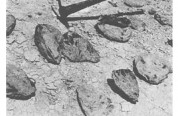Patagonian Oasis
Even amid the wind-swept desolation of southern Argentine a haven may occasionally be found.

Sheep raising is one of Patagonia’s principal industries and, consequently, wool one of its major exports.
They turned to with the idea of creating a new Wales, where language, customs, religion, and life in general were to be purely and exclusively Welsh. With pick and shovel they dug ditches and irrigated the alluvial flats of the Río Chubut with water from the river. Along the ditches and around the fields they planted poplars, now large and imposing. A railway was built from Gaiman and Trelew to the sea at Puerto Madryn. (It has now been extended up the valley to a point near Las Plumas.)
The idea of isolation and a new Wales did not work as expected; such ideas seldom do work out. There is still a distinctly Welsh atmosphere in much of the lower valley. Welsh faces are seen on every side, and the Welsh language is still spoken, but to the distress of the elders, the third and fourth generations, now appearing, tend more and more to be absorbed into the Argentine population. Spanish is the common language of the valley, and much of the best land and most profitable business is no longer in Welsh hands. The descendants of the pioneers have lost their spirit. They are not, as a class, particularly industrious or progressive, and the Welsh Colony cannot now be called flourishing. Such progress as now occurs is only in small part due to them.
The best part of the valley is the stretch of some twenty-five miles around Trelew and Gaiman, a smaller town about twelve miles from Trelew. The valley bottom here is from three to five miles wide and most of it is irrigated and fertile. There are probably at least forty thousand acres of useful land (the figure is my own guess, and I am sorry to say that I have not checked it with the official estimate). With varying degrees of comfort, this supports a population of several thousand people. The value of the oasis is clear from the fact that the same amount of land away from the river in this region would support about three families.
Oasis and Desert The contrast is amazing. There is this narrow band of arable land, a bare hairline on the map of Patagonia, and then at its edges, with no transition, begins a howling desert. Two minutes’ walk from Trelew or Gaiman, on the northern side of the valley, is enough to pass from pleasant country scenes to a dry land of pebbles, sand, and thorns. The steep valley walls rise abruptly from the river bottom. They are in most places absolutely barren cliffs and slopes of dazzling volcanic ash, slippery clay, or glistening gypsum.
The value of change is amusingly illustrated by the fact that when the citizens of fortunate Trelew take an afternoon off for a picnic, they do not as a rule go to some shady grove along the river. The favorite picnic ground is a place called “El Castillo,” “The Castle,” a round hill with castellated, in places vertical, sides, which is on the desert side of the valley margin and hence a desolate spot for an outing. This locality, incidentally, has more serious claims to fame than as a picnic site for the élite of Trelew. From its own slopes and those of the main valley wall near it have come many remains of fossil whales of the early Miocene, some twenty-five or thirty million years old.

Giant fossil oysters now found on the arid margins of Chubut Valley
We camped near the Castillo for a time in 1933, if it can be called camping to stay in a house and be fed by an excellent Italian cook.